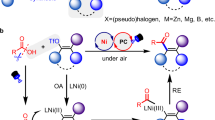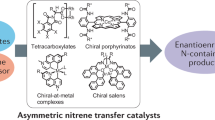Abstract
N-formylation and N-methylation of amines are important reactions that are used to produce a wide range of key intermediates and compounds. This protocol describes the environmentally benign N-formylation and N-methylation of primary and secondary amines using carbon dioxide (CO2) as the carbon source, hydrosilanes as reductants and N-heterocyclic carbenes (NHCs) as catalysts. Using CO2 as a reagent has the advantage of low cost and negligible toxicity. However, the catalyst is air-sensitive and must be generated fresh before use; consequently, the techniques used to prepare and manipulate the catalyst are described. The synthetic approach described in this protocol does not use any toxic reagents; using the appropriate catalyst, N-formylated or N-methylated products can be obtained with high selectivity. The overall time for catalyst preparation and for conducting several catalytic reactions in parallel is 15–48 h, depending on the nature of the substrates.
This is a preview of subscription content, access via your institution
Access options
Access Nature and 54 other Nature Portfolio journals
Get Nature+, our best-value online-access subscription
$29.99 / 30 days
cancel any time
Subscribe to this journal
Receive 12 print issues and online access
$259.00 per year
only $21.58 per issue
Buy this article
- Purchase on Springer Link
- Instant access to full article PDF
Prices may be subject to local taxes which are calculated during checkout








Similar content being viewed by others
References
Liu, Q., Wu, L., Jackstell, R. & Beller, M. Using carbon dioxide as a building block in organic synthesis. Nat. Commun. 6, 1–15 (2015).
Li, Y., Sorribes, I., Yan, T., Junge, K. & Beller, M. Selective methylation of amines with carbon dioxide and H2 . Angew. Chem. Int. Ed. Engl. 52, 12156–12160 (2013).
Li, Y., Fang, X., Junge, K. & Beller, M. A general catalytic methylation of amines using carbon dioxide. Angew. Chem. Int. Ed. Engl. 125, 9747–9750 (2013).
Beydoun, K., Vom Stein, T., Klankermayer, J. & Leitner, W. Ruthenium-catalyzed direct methylation of primary and secondary aromatic amines using carbon dioxide and molecular hydrogen. Angew. Chem. Int. Ed. Engl. 52, 9554–9557 (2013).
Jacquet, O., Das Neves Gomes, C., Ephritikhine, M. & Cantat, T. Recycling of carbon and silicon wastes: room temperature formylation of N-H bonds using carbon dioxide and polymethylhydrosiloxane. J. Am. Chem. Soc. 134, 2934–2937 (2012).
Jacquet, O., Frogneux, X., Das Neves Gomes, C. & Cantat, T. CO2 as a C1-building block for the catalytic methylation of amines. Chem. Sci. 4, 2127 (2013).
Zhou, Q. & Li, Y. The real role of N-heterocyclic carbene in reductive functionalization of CO2: an alternative understanding from density functional theory study. J. Am. Chem. Soc. 137, 10182–10189 (2015).
Riduan, S.N., Ying, J.Y. & Zhang, Y. Mechanistic insights into the reduction of carbon dioxide with silanes over N-heterocyclic carbene catalysts. ChemCatChem 5, 1490–1496 (2013).
Das, S., Bobbink, F.D., Laurenczy, G. & Dyson, P.J. Metal-free catalyst for the chemoselective methylation of amines using carbon dioxide as a carbon source. Angew. Chem. Int. Ed. Engl. 53, 12876–12879 (2014).
Das, S., Bobbink, F.D., Bulut, S., Soudani, M. & Dyson, P.J. Thiazolium carbene catalysts for the fixation of CO2 onto amines. Chem. Commun. 52, 2497–2500 (2016).
Tlili, A., Frogneux, X., Blondiaux, E. & Cantat, T. Creating added value with a waste: methylation of amines with CO2 and H2 . Angew. Chem. Int. Ed. Engl. 53, 2543–2545 (2014).
Tlili, A., Blondiaux, E., Frogneux, X. & Cantat, T. Reductive functionalization of CO2 with amines: an entry to formamide, formamidine and methylamine derivatives. Green Chem. 17, 157–168 (2015).
González-Sebastián, L., Flores-Alamo, M. & García, J.J. Selective N-methylation of aliphatic amines with CO2 and hydrosilanes using nickel-phosphine catalysts. Organometallics 34, 763–769 (2015).
Chong, C.C. & Kinjo, R. Hydrophosphination of CO2 and subsequent formate transfer in the 1,3,2-diazaphospholene-catalyzed N-formylation of amines. Angew. Chem. Int. Ed. Engl. 54, 12116–12120 (2015).
Riduan, S.N., Ying, J.Y. & Zhang, Y. Solid poly-N-heterocyclic carbene catalyzed CO2 reduction with hydrosilanes. J. Catal. 343, 46–51 (2016).
Hao, L. et al. Imidazolium-based ionic liquids catalyzed formylation of amines using carbon dioxide and phenylsilane at room temperature. ACS Catal. 5, 4989–4993 (2015).
Frogneux, X., Blondiaux, E., Thuéry, P. & Cantat, T. Bridging amines with CO2: organocatalyzed reduction of CO2 to aminals ACS Catal. 5, 3983–3987 (2015).
Zhang, S. et al. Copper-catalyzed N-formylation of amines with CO2 under ambient conditions. RSC Adv. 6, 32370–32373 (2016).
Nale, D.B. & Bhanage, B.M. An efficient protocol for formylation of amines using carbon dioxide and PMHS under transition-metal-free conditions. Synlett 27, 1413–1417 (2016).
Lv, H., Xing, Q., Yue, C., Lei, Z. & Li, F. Solvent-promoted catalyst-free N-formylation of amines using carbon dioxide under ambient conditions. Chem. Commun. 52, 6545–6548 (2016).
Moret, S., Dyson, P.J. & Laurenczy, G. Direct synthesis of formic acid from carbon dioxide by hydrogenation in acidic media. Nat. Commun. 5, 4017 (2014).
Sorribes, I., Junge, K. & Beller, M. Direct catalytic N-alkylation of amines with carboxylic acids. J. Am. Chem. Soc. 136, 14314–14319 (2014).
Fu, M.C., Shang, R., Cheng, W.M. & Fu, Y. Boron-catalyzed N-alkylation of amines using carboxylic acids. Angew. Chem. Int. Ed. 54, 9042–9046 (2015).
Acknowledgements
We thank the Ecole polytechnique fédérale de Lausanne (EPFL) and the Commission for Technology and Innovation (CTI) Swiss Competence Centre of Energy Research (SCCER) for financial support.
Author information
Authors and Affiliations
Contributions
F.D.B., S.D. and P.J.D. planned the original project. F.D.B. performed the catalytic reactions in the protocol. F.D.B. and P.J.D. wrote the protocol.
Corresponding author
Ethics declarations
Competing interests
The authors declare no competing financial interests.
Rights and permissions
About this article
Cite this article
Bobbink, F., Das, S. & Dyson, P. N-formylation and N-methylation of amines using metal-free N-heterocyclic carbene catalysts and CO2 as carbon source. Nat Protoc 12, 417–428 (2017). https://doi.org/10.1038/nprot.2016.175
Published:
Issue Date:
DOI: https://doi.org/10.1038/nprot.2016.175
This article is cited by
-
Catalyst-free fixation of carbon dioxide into value-added chemicals: a review
Environmental Chemistry Letters (2021)
-
N-doped carbon supported Pd catalysts for N-formylation of amines with CO2/H2
Science China Chemistry (2018)
Comments
By submitting a comment you agree to abide by our Terms and Community Guidelines. If you find something abusive or that does not comply with our terms or guidelines please flag it as inappropriate.



